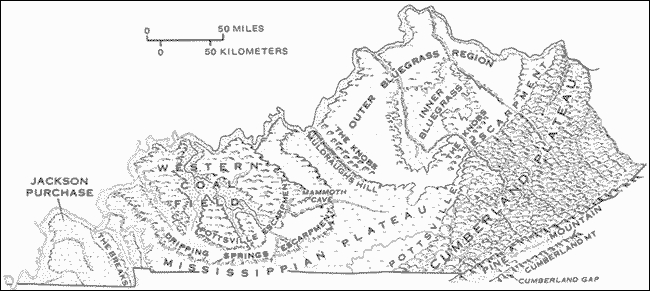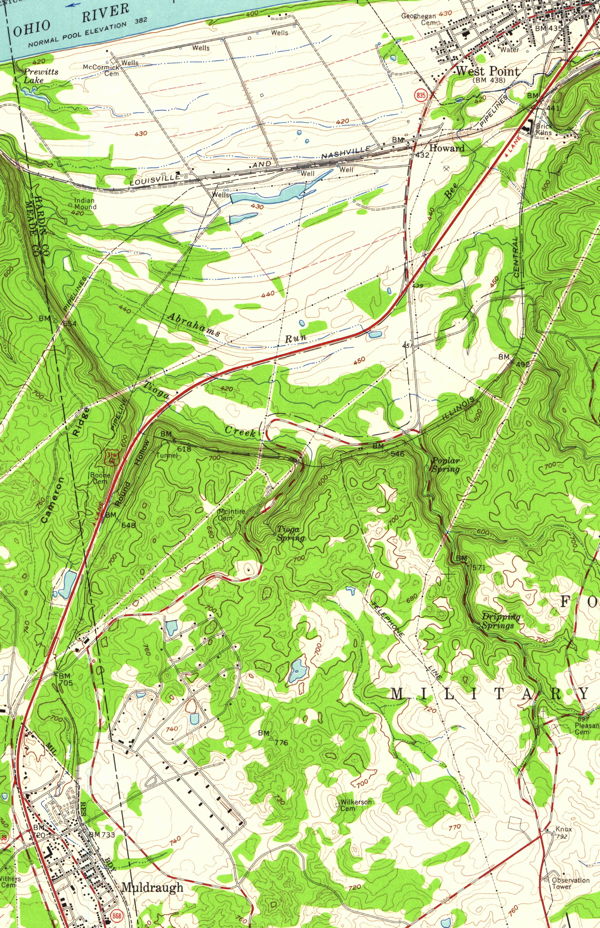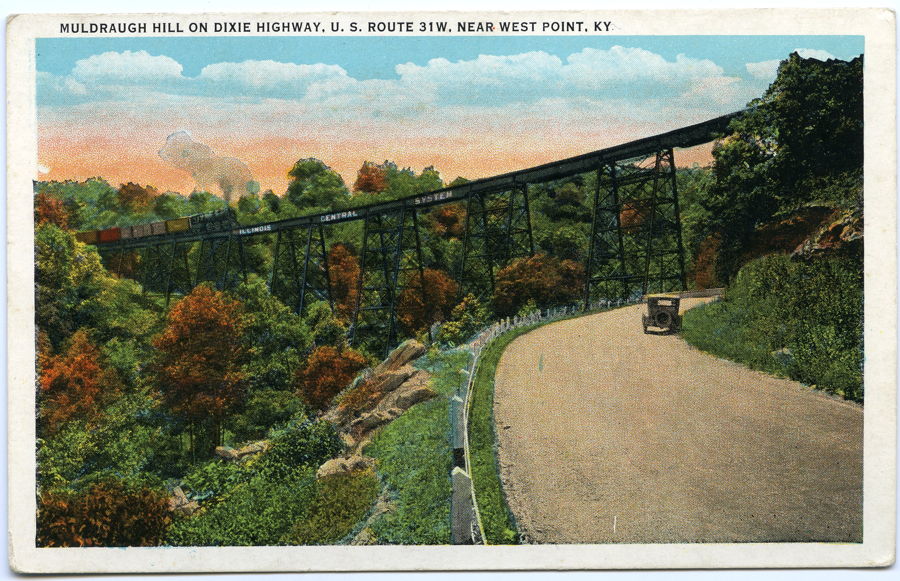
The following article by Charles Hartley originally appeared in The Courier-Journal on 10 Aug 2014. It is archived here with additional information for your reading enjoyment.
Remember when gas was cheap, and a drive in the country was a pleasant way to spend a Sunday afternoon?
When we first moved to Shepherdsville nearly fifty years ago, we'd pick out a road we hadn't traveled to see what lay along it. One of the first roads was Highway 44 from Shepherdsville to Dixie Highway. I remember being impressed by what almost seemed like a mountain at the time, just west of where Bullitt's Lick lay. Of course it's nothing like a mountain, but in about a mile the road climbs nearly 400 feet, and then after traveling along that ridge top for a spell, the road drops back down about the same distance to the valley of Knob Creek and its tributaries.
We also explored many of the winding roads that pass among the hills of northwestern Bullitt County, roads like Mt. Elmira Road, Martin Hill Road, Brooks Hill Road, and Knob Creek Road that becomes Mitchell Hill Road before running into Manslick Road near Fairdale. In each case the roads reminded us of just how hilly that part of the county is.

When I wrote about Cahill's Knob last time, it got me to thinking about these trips, and the roads we'd traveled, and what, if anything, was the difference between a hill and a knob. Generally speaking, a knob is like a rounded hill that sticks up by itself from the land around it. We have a lot of knobs in this area. One prominent one is McDonald's Knob which stands just west of I-65 near the Shepherdsville exit. You probably know which one it is, because the folks who built Settler's Point in Shepherdsville used much of the sides of that knob to fill in the low land nearby.

Actually, there is a whole region called "The Knobs" that sits like an irregular horseshoe around the Bluegrass region. It goes by various names, depending on where you are, but the part that interests us here generally goes by the name of Muldraugh Hill (shown on the drawing).
You can get a sense of it by traveling down Dixie Highway past West Point to where the road climbs up the hill to the small community named Muldraugh. Or travel down I-65 past Lebanon Junction to where the Joe Prather Highway leads to the west toward Radcliff.

There it's about 450 feet above sea level, but by the time you reach Dixie Highway you've traveled up about 350 feet, most of it in the first few miles. Or continue on I-65 toward Elizabethtown and climb that section that is so pretty in the fall when the leaves are changing, or the spring when the redbuds and dogwoods are in bloom.
So, how did all of these knobs and hills come about anyway? Towns like Muldraugh, Radcliff, Elizabethtown, and Hodgenville all sit on a plateau that rests between 700 and 800 feet above sea level, while West Point, Shepherdsville, Lebanon Junction, Boston and Louisville all sit in a valley 300 to 400 feet below; and between them sits all these hills and knobs.
Ages ago the front edge of the Muldraugh Hill plateau, called an escarpment, was essentially continuous north and south, separating the flow of waterways east and west. At that time the Ohio River was on the west, or upper side of the plateau edge, and Salt River, on the east side, ran northward, far into Indiana.
The difference in elevation of the two sides of this escarpment was high enough to separate the two drainage basins.
Then the glaciers of the last Ice Age restricted the Salt River from flowing northward. The river ponded, rising until it spilled over into the western basin. Erosion did the rest. Slowly, bit by bit, waters running off the plateau edge carved pathways by gravitating to the lowest spots.
As they bit deeper and deeper into the softer shale rock that lay beneath the harder limestone cap, deep cut valleys with ridge tops formed along with some isolated rounded hills that we call knobs. Today these make up much of northwestern Bullitt County and the Jefferson Forest region.
We don't travel these roads that much anymore, but it's nice to remember when we did. I bet many of you have some of these same kinds of memories. Perhaps you'll spend this Sunday afternoon just remembering.

Copyright 2014 by Charles Hartley, Shepherdsville KY. All rights are reserved. No part of the content of this page may be included in any format in any place without the written permission of the copyright holder.
The Bullitt County History Museum, a service of the Bullitt County Genealogical Society, is located in the county courthouse at 300 South Buckman Street (Highway 61) in Shepherdsville, Kentucky. The museum, along with its research room, is open 10 a.m. to 4 p.m. Monday through Friday. Saturday appointments are available by calling 502-921-0161 during our regular weekday hours. Admission is free. The museum, as part of the Bullitt County Genealogical Society, is a 501(c)3 tax exempt organization and is classified as a 509(a)2 public charity. Contributions and bequests are deductible under section 2055, 2106, or 2522 of the Internal Revenue Code. Page last modified: 12 Sep 2024 . Page URL: bullittcountyhistory.org/memories/hills_knobs.html